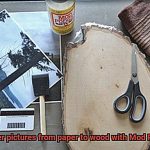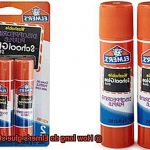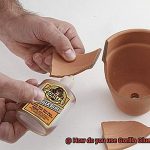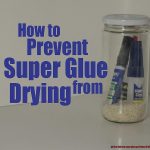Have you ever had your heart broken when a beloved item of yours shatters into pieces? It’s a painful experience, especially if that item holds sentimental value. But what if we told you there’s a way to bring it back to life?
Enter the power couple of super glue and baking soda. You might be thinking, “how strong is this duo when it comes to fixing shattered items?” Well, let us tell you – their restorative abilities are often underestimated, and it’s high time we uncover the science behind their effectiveness.
Super glue and baking soda team up to create an unbreakable bond that can withstand even the toughest conditions. The mixture forms a sturdy filling that can be shaped and sanded to perfection, making it ideal for repairing gaps and cracks. The adhesive properties of super glue ensure a long-lasting connection while baking soda adds reinforcement and stability.
This method is not only cost-effective but also saves you from having to replace expensive items. And the best part? It takes just a few minutes to execute. But how well does it hold up against wear and tear? Join us as we explore the durability of super glue and baking soda and see how long they can keep your cherished possessions intact in various situations.
What Is Super Glue and Baking Soda?
Contents
This powerful combination creates a bond that is not only strong and durable but also perfect for repairing objects that experience constant use or pressure.
Super glue, also known as cyanoacrylate adhesive, is a fast-acting adhesive that bonds quickly and securely to various materials such as plastic, metal, wood, and ceramics. However, without the addition of baking soda, super glue can become brittle over time, causing the bond to break under stress.
This is where baking soda comes in. The fine white powder commonly used in baking and cooking acts as a filler and strengthens the bond between two surfaces. When mixed with super glue, it creates a mixture that is perfect for filling gaps or repairing broken objects.
But before you start mixing these two substances together, there are a few things to keep in mind. Firstly, ensure that the surface is clean and dry before applying the mixture. Secondly, apply the glue in small amounts followed by a sprinkling of baking soda. Allow the mixture to dry for a few minutes before brushing off any excess powder.
The benefits of this technique are numerous. Not only does it create a strong and durable bond, but it’s also cost-effective and easy to use. Moreover, it helps to thicken the super glue, making it easier to apply and allowing it to fill in gaps and cracks more effectively.
It’s important to note that this technique may not work well on porous materials such as wood or fabric as the baking soda may not adhere properly. Additionally, it should not be used on surfaces that will be exposed to high temperatures or moisture as this can weaken the bond over time.
How Does Super Glue and Baking Soda Create a Bond?
Fear not, because the combination of super glue and baking soda can create a bond that is both strong and durable. This process is called cyanoacrylate welding, and it allows these two materials to work together to form a powerful adhesive.
To begin the process, simply spread a layer of baking soda over one surface and apply a few drops of super glue to the other surface. When the two surfaces are pressed together, the chemical reaction between the super glue and baking soda begins.
Super glue, also known as cyanoacrylate adhesive, works by forming tight molecular bonds when it comes into contact with moisture. Baking soda contains sodium bicarbonate which reacts with the acidic cyanoacrylate molecules in super glue to create a hard and durable material.
The result is a bond that is tough and long-lasting, making it ideal for fixing a wide range of items around the home. From broken ceramics to plastic toys, this simple yet effective technique can be used to fix almost anything.
It’s important to note that this technique should only be used on non-porous surfaces that are clean and dry. Avoid using it on porous materials or surfaces exposed to high temperatures or moisture.
Durability of the Bond
This dynamic duo creates a bond that is stronger than anything else on the market and can fix even the most challenging materials.
But why is this bond so durable? Let’s dive deep into the science behind this incredible adhesive.
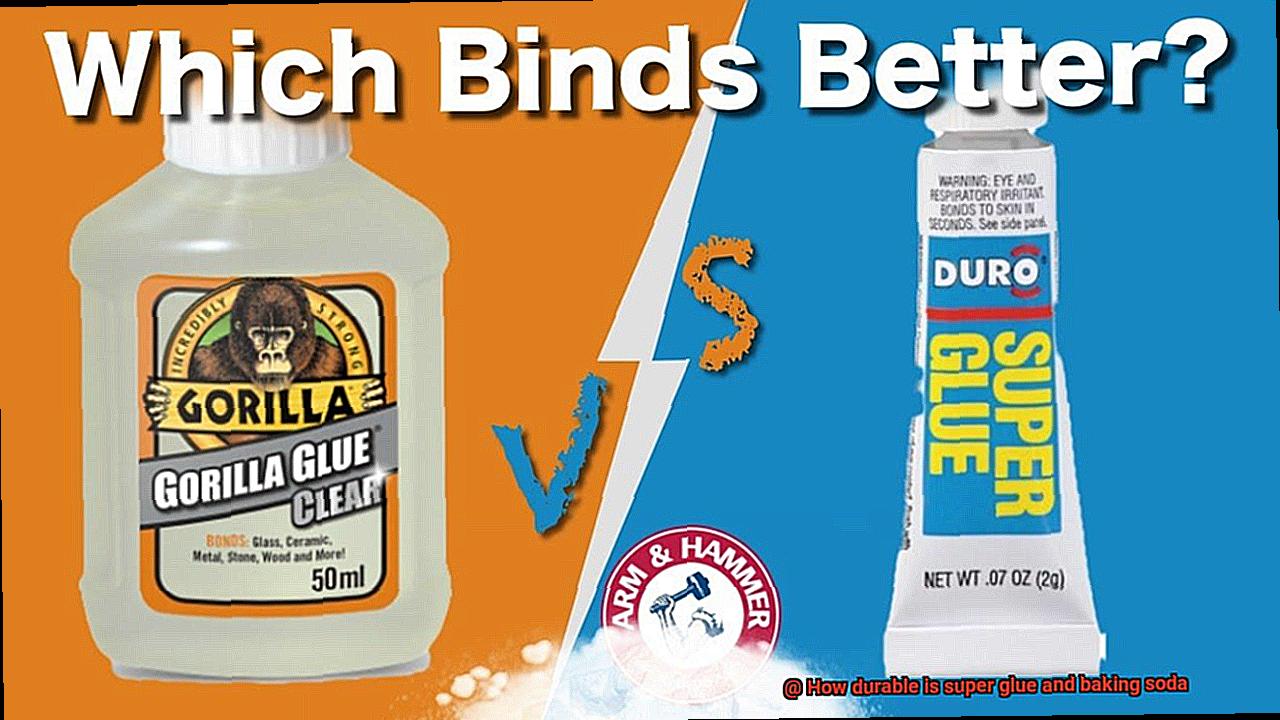
Firstly, baking soda plays a critical role in making this bond incredibly strong. It acts as a filler, closing any gaps present in the surface. By filling in these gaps, it creates a tight seal that is essential to the bond’s longevity. Without this crucial component, super glue alone may not be able to fill gaps entirely, which can weaken the bond.
Secondly, when you mix super glue and baking soda, they create a chemical reaction that produces heat. This heat causes the super glue to dry faster, creating an even stronger bond. The baking soda also hardens during this reaction, further strengthening the bond. This chemical reaction is what makes this combination so unique and valuable.
Finally, the durability of the bond between super glue and baking soda is so strong that it can repair even the most challenging materials such as plastic, metal, or wood. Once you’ve applied this adhesive, you can sand it down and paint over it. The resulting surface is hard and durable enough to withstand pressure and tension.
Factors That Affect Durability
If you’ve ever struggled with weak bonds that just can’t hold up to the test of time, super glue and baking soda may be the perfect solution. But before you begin your bonding project, it’s important to know what factors can impact the durability of this powerful pairing.
One of the most crucial factors that affects the strength of a super glue and baking soda bond is the type of surface being bonded. Non-porous and smooth surfaces, such as plastic, metal, and glass, are ideal for this type of bond. However, rough or porous surfaces like fabric or wood may pose a challenge and not provide the same level of durability.
Another key factor to consider is the amount of pressure applied during bonding. While it’s easy to assume that more pressure will result in a stronger bond, applying too much pressure can actually cause it to weaken or break over time. Adhering to the manufacturer’s instructions for applying the glue and baking soda mixture is essential for achieving optimal strength and durability.
Lastly, environmental factors can also play a significant role in a super glue and baking soda bond’s durability. Exposure to extreme temperatures, moisture, or chemicals can all contribute to weakening or breaking down the bond over time. Always keep these factors in mind when using super glue and baking soda for bonding applications.
Benefits of Using Super Glue and Baking Soda
Look no further than the dynamic duo of super glue and baking soda. These two common household items, when combined, create a remarkably strong bond that has numerous benefits.
Firstly, one of the primary benefits of using super glue and baking soda is their ability to create a durable and long-lasting bond. The baking soda acts as a filler that strengthens the glue, making it perfect for working with damaged or irregular surfaces. This powerful combination fills in gaps and creates a seamless connection, ensuring a solid bond.
Secondly, the versatility of this mixture is truly remarkable. It can be used on a variety of materials such as wood, plastic, metal, and ceramics, making it an ideal choice for DIY projects or repairing broken items. Whether you’re fixing a broken vase or building a new piece of furniture, you can count on this powerful combination to get the job done.
Moreover, super glue and baking soda dry quickly, which means that you don’t have to wait long before handling your repaired item. This feature is especially useful when trying to hold pieces together while the glue dries. Additionally, this quick-drying feature makes it easier to work with, allowing you to finish your project faster.
Lastly, using super glue and baking soda is cost-effective. Both materials are readily available at most grocery stores or hardware stores and are inexpensive. So, no need to break the bank on expensive adhesives when you have this powerful combination at your disposal.
Application Tips for Maximum Durability
Super glue and baking soda are a dynamic duo when it comes to creating a strong and durable bond. Whether you’re repairing a broken object or creating something new, here are some tips to help you achieve maximum durability with this combination.
Clean and Dry Surfaces
The first step in creating a strong bond is to make sure that the surfaces being bonded are clean and dry. Dirt, dust, and moisture can compromise the strength of the bond, so it’s essential to wipe down the surfaces with a clean cloth or paper towel before applying the glue and baking soda mixture.
Apply Thin Layers
When applying the mixture, it’s crucial to use thin layers of both super glue and baking soda. Avoid adding too much glue or baking soda, as this can cause the bond to become brittle and break more easily. Thin layers build up a stronger bond over time without compromising its durability.

Use Baking Soda Specifically
Using baking soda specifically is essential for creating a strong bond. Other powders may not have the same effect as baking soda, which acts as a filler between the surfaces being bonded. This creates a stronger bond overall.
Allow Each Layer to Dry Completely
Each layer of super glue and baking soda must dry completely before adding another layer. This process helps to build up a strong and durable bond over time. Rushing this step can result in a weaker bond that may break more easily.
Avoid Putting Stress on the Bond
Once the glue has fully dried, avoid putting any unnecessary stress or pressure on the bond for at least 24 hours after application. This includes excessive twisting, bending, or pulling on the glued surfaces. Letting the bond fully cure before putting it under stress will help ensure maximum durability.
In addition to these tips, properly storing your super glue is also crucial for maximum durability. Keep it in a cool, dry place away from sunlight and heat sources, and make sure the cap is securely fastened when not in use. Testing the mixture on a small area first before committing to a larger project is also recommended, and only use it on non-porous surfaces such as metal, plastic, or glass.
Surfaces Not Suitable for This Combination
Super glue and baking soda are a popular combination for creating a long-lasting bond. However, it’s important to know which surfaces may not be suitable for this method.
Firstly, it’s crucial to consider the surface type. Hard, non-porous surfaces such as metal, plastic, and ceramic are the best candidates for this combination. On the other hand, porous surfaces like wood or fabric may not bond as effectively. Since baking soda may not fully bond with porous surfaces, it could result in a weaker bond.
Another critical factor to keep in mind is moisture and oil. If the surface has any moisture or oil present, it can interfere with the bonding process of the super glue and baking soda mixture. This could result in a weaker bond or no bond at all.
Moreover, extreme temperatures can also affect the strength of the bond. Surfaces exposed to extreme heat or cold may weaken or break altogether.
To ensure maximum durability and a long-lasting bond, it’s always best to test on a small inconspicuous area first before applying the mixture to the entire surface. By doing so, you can avoid any adverse effects on your project.
cfiQxFqco34″ >
Conclusion
To sum up, the combination of super glue and baking soda is a formidable force that creates an unbreakable bond. This technique is perfect for fixing damaged items that have sentimental or monetary value, as it ensures a long-lasting connection. With its adhesive properties, super glue creates a sturdy foundation, while baking soda adds reinforcement and stability.
The durability of this bond is impressive thanks to the chemical reaction between the two materials. Baking soda acts as an excellent filler, closing any gaps present in the surface and creating a tight seal that’s essential to the bond’s longevity. When mixed with super glue, it produces heat that causes the glue to dry faster and creates an even stronger hold.
However, it’s important to note that this technique may not work well on porous materials like wood or fabric since baking soda may not adhere correctly. Additionally, it shouldn’t be used on surfaces exposed to high temperatures or moisture as this can weaken the bond over time.
To achieve maximum durability with this combination, follow specific application tips such as using thin layers and allowing each layer to dry completely before adding another one. Proper storage of your super glue in a cool, dry place away from sunlight and heat sources is also crucial.
Overall, using super glue and baking soda is an affordable and straightforward way to repair broken items around your home.


